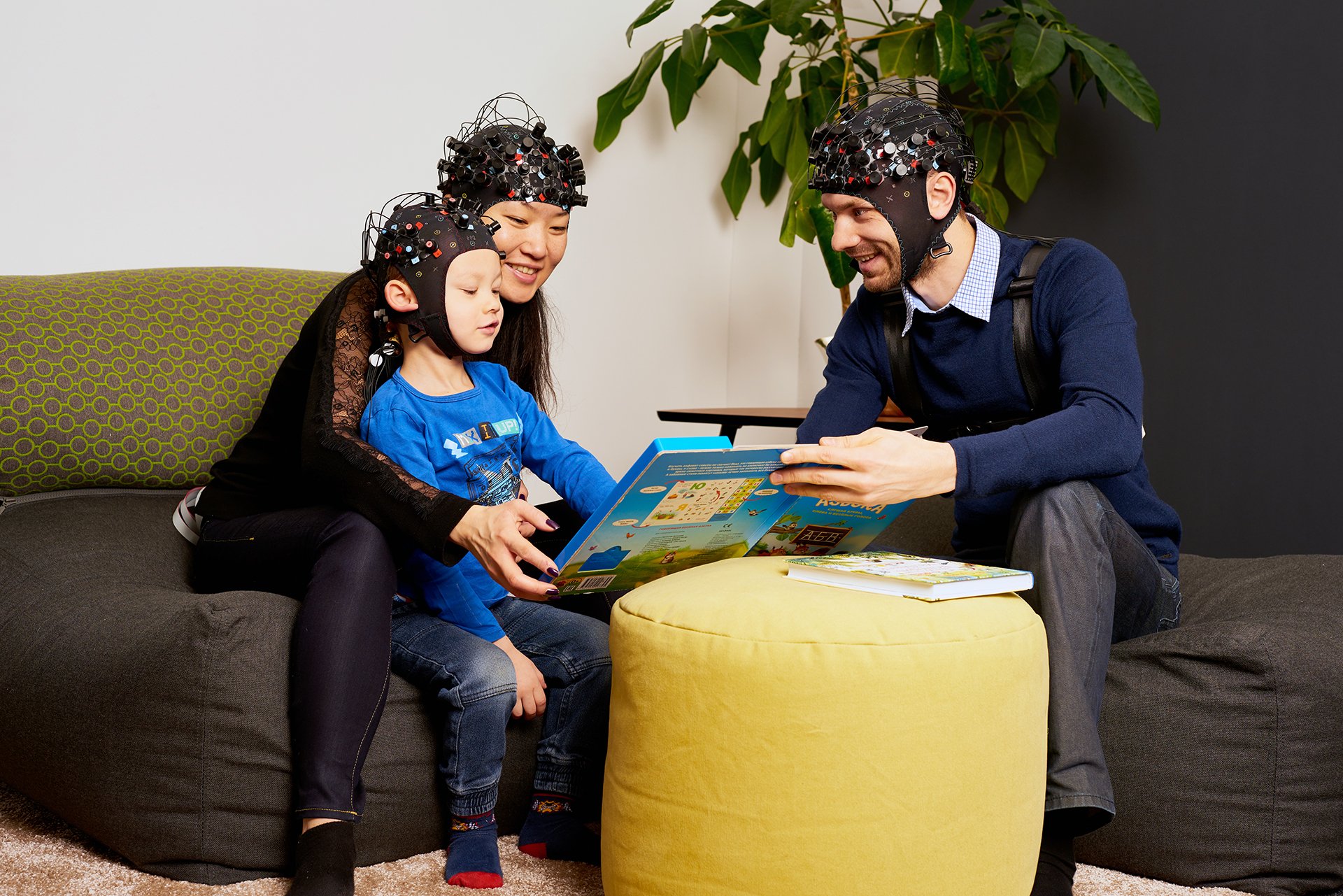
Hyperscanning refers to neuroimaging multiple people at the same time to study how they interact. By simultaneously recording from more than one brain, not only intra- but also inter-brain neural relations can be investigated (Czeszumski et al., 2020).
It is common to use functional connectivity (FC) to quantify this synchronization. The analysis method looks quite similar to FC with one subject; the difference being that the synchrony between regions in the brains of different subjects are analyzed rather than within a subject.
Advantages & Applications
Most brain areas that are of relevance in social neuroscience research are part of the cortical surface, making them suitable for fNIRS measurements (Ono, 2018). Depending on the paradigm and hypothesis, one could look at FC between the same region in different subjects, or different regions within different subjects – say, synchronization between Broca’s area in a subject that is speaking compared to and Wernicke’s area in a subject that is listening.
Unlike fMRI and EEG, fNIRS allows to measure cortical activity without restraining the subject’s usual behavior in a social interaction, allowing for a higher ecological validity of the measurements.
Possible applications of hyperscanning with fNIRS include, but are not limited to: mother-child interaction (e.g. Azhari et al., 2019), cooperation and competition studies (e.g. Li et al., 2021 or Balconi et al., 2017), teamwork (Mayseless et al., 2019) or social self-perception (e.g. Balconi & Vanutelli, 2016).
Functionality
When hyperscanning, it is critical to ensure that the timing between data streams is synchronized. This is implemented in all our hyperscanning solutions. With our data acquisition softwares NIRStar and Aurora, users are enabled to control all subjects at once from one single GUI.
The hyperscanning measurement can take a variety of forms: Both NIRx platforms, NIRScout & NIRSport2, offer imaging of two subjects within one device or multiple subjects with multiple devices.
Single device Hyperscanning with NIRStar.
NIRStar
The NIRScout system offers a lab based solution for measuring two subjects at the same time with our NIRStar data acquisition software.
Single device Hyperscanning with the Hyperscanning application for Aurora.
Hyperscanning App for Aurora
Our mobile NIRSport2 device allows subjects to interact with each other in a natural and unconstrained way. The designated Hyperscanning application for Aurora offers high flexibility in terms of recording connection, number of devices and montage layout for individual subjects. Users can choose between single device (two subjects) and multiple device hyperscanning (see below).
Regardless of the number of devices (single vs. multiple), you may select a different montage for each subject. When working with multiple devices, the connection mode can also be different across devices.
Illustration of different montage and connection options.
To further increase the number of optodes, one may want to combine hyperscanning with our tandem functionality. In this way, you may achieve a higher coverage for some or all subjects
Tandem mode with Hyperscanning application.
There have been over 1000 publications with our systems, check out more papers on this page or view the selected references on hyperscanning below.
+ Selected References
Azhari, A., Leck, W. Q., Gabrieli, G., Bizzego, A., Rigo, P., Setoh, P., Bornstein, M. H., & Esposito, G. (2019). Parenting Stress Undermines Mother-Child Brain-to-Brain Synchrony: A Hyperscanning Study. Scientific Reports, 9(1). https://doi.org/10.1038/s41598-019-47810-4
Czeszumski, A., Eustergerling, S., Lang, A., Menrath, D., Gerstenberger, M., Schuberth, S., Schreiber, F., Rendon, Z. Z., & König, P. (2020). Hyperscanning: A Valid Method to Study Neural Inter-brain Underpinnings of Social Interaction. Frontiers in Human Neuroscience, 14. https://doi.org/10.3389/fnhum.2020.00039
Balconi, M. & Vanutelli, M.E. (2016). “Interbrains cooperation: Hyperscanning and self-perception in joint actions,” Journal of Clinical and Experimental Neuropsychology, vol. 0, no. 0, pp. 1–14. https://doi.org/10.1080/13803395.2016.1253666
Balconi, M. & Vanutelli, M.E. (2017). “Brains in Competition: Improved Cognitive Performance and Inter-Brain Coupling by Hyperscanning Paradigm with Functional Near-Infrared Spectroscopy,” Frontiers in Behavioral Neuroscience, vol. 11. https://doi.org/10.3389/fnbeh.2017.00163
Li, R., Mayseless, N., Balters, S., & Reiss, A. L. (2021). “Dynamic Inter-Brain Synchrony in Real-life Inter-Personal Cooperation: A Functional Near-infrared Spectroscopy Hyperscanning Study.” NeuroImage, 118263. https://doi.org/10.1016/j.neuroimage.2021.118263
Mayseless, N., Hawthorne, G., & Reiss, A. L. (2019). “Real-life creative problem solving in teams: fNIRS based hyperscanning study.” NeuroImage, 203, 116161.https://doi.org/10.1016/j.neuroimage.2019.116161
Ono, Y., (2018): “fNIRS Hyperscanning: A door to real-world social neuroscience research.” [online] fnirs.org. Available at: https://fnirs.org/2018/02/fnirs-hyperscanning-2018/






